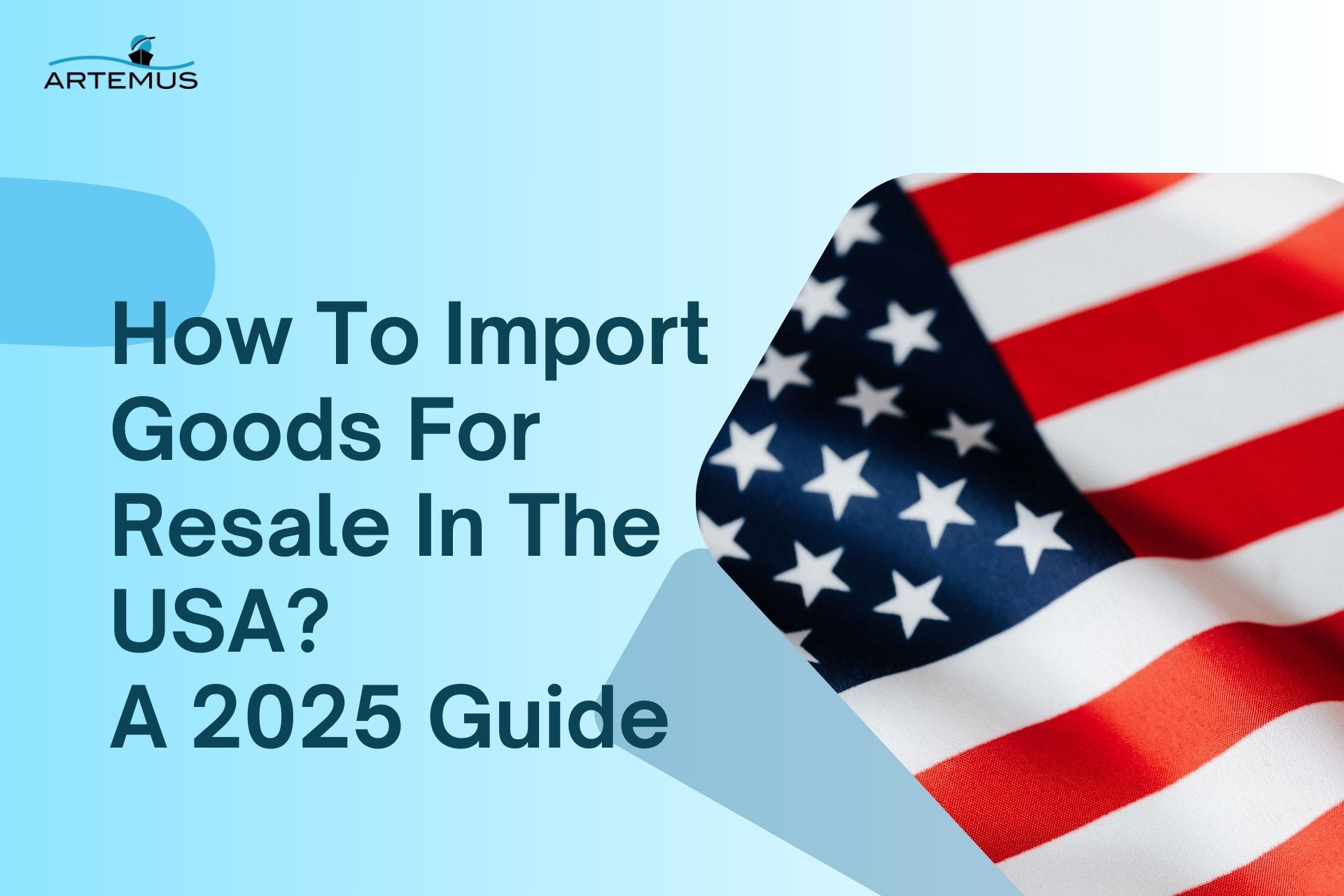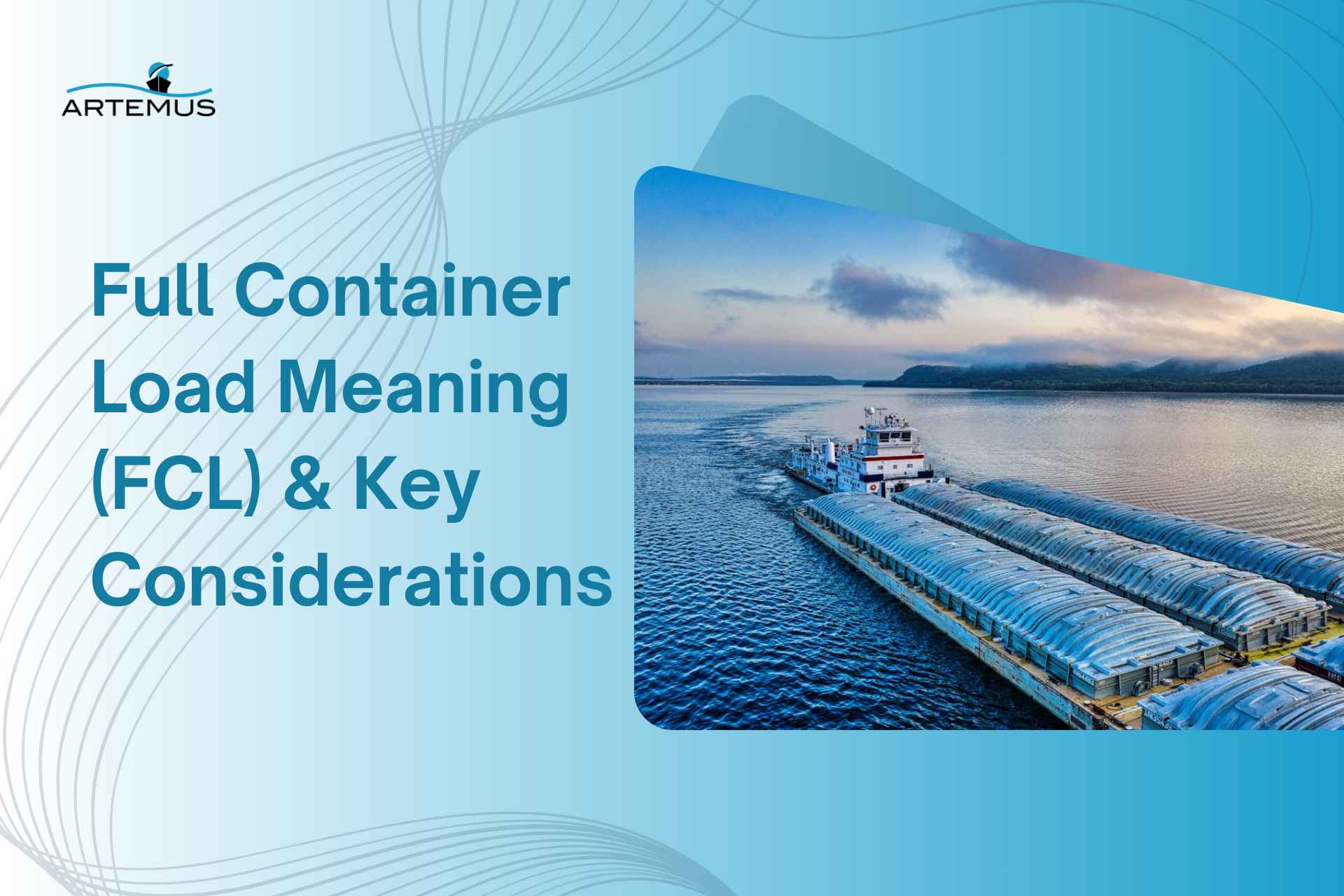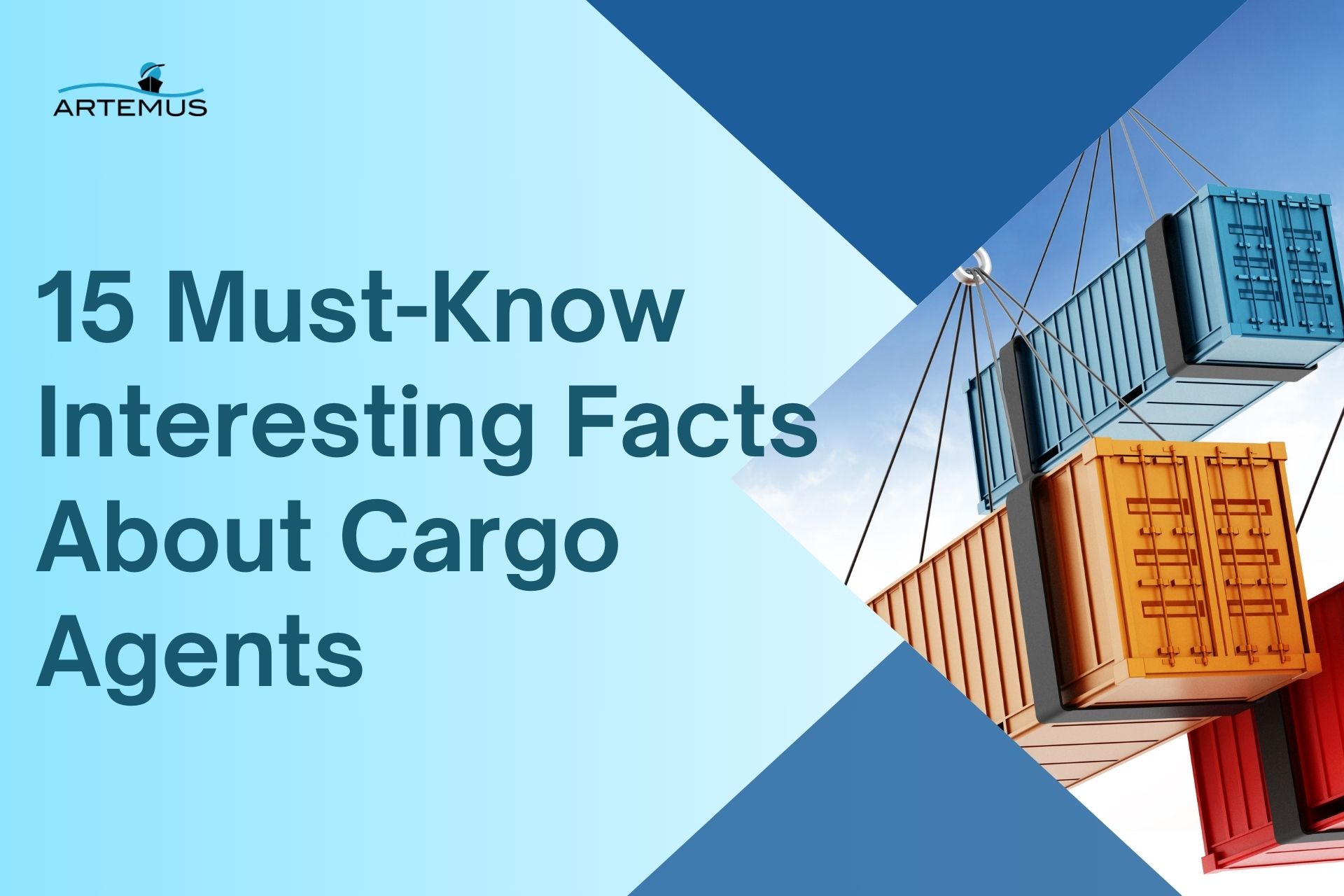
How To Import Goods For Resale In The USA? A 2025 Guide
Importing goods for resale in the USA presents a lucrative business opportunity, but navigating the complexities of U.S. customs regulations,

In the world of international shipping, choosing the right method for transporting goods can make a significant difference in efficiency and cost. Full Container Load (FCL) is a popular option for businesses with substantial cargo, offering several advantages over other shipping methods.
FCL means you reserve an entire container solely for your shipment, optimizing space and reducing handling risks. However, before deciding on FCL, there are key considerations to keep in mind, such as shipping costs, cargo volume, and transit times.
For businesses seeking seamless domestic transportation solutions, Artemus is here to help. Request a domestic transportation quote today and explore how our advanced software solutions for ISF & AMS filing can simplify your shipping processes.
Table Of Contents
Full Container Load (FCL) refers to a shipping method where a single customer or shipment exclusively uses an entire container. Unlike Less than Container Load (LCL), where multiple shipments from different customers share the same container, FCL offers the advantage of complete control over the entire container’s contents.
This means that the shipper can utilize the container’s full capacity without sharing space with other cargo, ensuring the goods are handled less frequently, and reducing the risk of damage.
FCL is often the preferred choice for businesses with large shipments, as it provides greater security, quicker transit times, and more cost-effective options when shipping in bulk.
It also streamlines logistics by keeping the container sealed from the point of origin to the destination, reducing the risk of theft or tampering.
Related: How Long Does Sea Cargo Take? What To Expect
Understanding the key terms related to Full Container Load (FCL) is essential for anyone involved in international shipping. Whether you’re a seasoned shipper or new to logistics, familiarizing yourself with these terms can help streamline the shipping process, ensure smooth communication, and avoid costly misunderstandings.
Here are five important terms that every FCL shipper should know.
The Bill of Lading is a crucial document in FCL shipping, acting as a contract between the shipper and the carrier. It serves as a receipt for the goods loaded into the container and provides details about the shipment, such as the type of cargo, destination, and terms of delivery.
The BOL is essential for claiming ownership of the goods at the destination and is often required for customs clearance.
TEU is a standard measurement used in the shipping industry to describe the capacity of a container. A TEU represents the dimensions of a standard 20-foot shipping container.
FCL shipments often reference TEU to indicate the volume or capacity being utilized.
For example, a 40-foot container would be equivalent to 2 TEUs. Understanding TEU helps shippers determine the appropriate container size for their cargo.
A container seal is a tamper-evident device used to secure the container door after loading. This seal is crucial for maintaining the integrity and security of the cargo during transit. Once the container is sealed, it remains sealed until it reaches its final destination.
The seal number is recorded on the Bill of Lading, and any discrepancy in the seal at the destination can indicate potential tampering or theft.
A freight forwarder is a third-party logistics provider that serves as a bridge between the shipper and multiple transportation services.In FCL shipping, freight forwarders handle the coordination of the container’s journey, including booking space on a vessel, arranging inland transportation, and managing customs clearance.
They play a vital role in ensuring the smooth and efficient movement of goods from origin to destination.
They are a set of predefined rules published by the International Chamber of Commerce (ICC) that define the responsibilities of buyers and sellers in international trade. In the context of FCL shipping, Incoterms determines who is responsible for costs, risks, and documentation at various stages of the shipment.
Common Incoterms used in FCL include FOB (Free on Board), CIF (Cost, Insurance, and Freight), and EXW (Ex Works). Understanding these terms is essential for negotiating contracts and ensuring a clear understanding of responsibilities between parties.
Related: What Is Ocean Freight? Everything You Need to Know

When shipping goods internationally, understanding the differences between Full Container Load (FCL) and Less Container Load (LCL) can help you choose the most efficient and cost-effective method. Here are five key differences between FCL and LCL:
FCL: In Full Container Load (FCL) shipping, the entire container is exclusively used by a single shipper. The container is filled with goods from just one customer, offering full control over the cargo and eliminating the need to share space with other shipments.
LCL: Less Container Load (LCL) involves sharing container space with shipments from other customers. The container is filled with multiple smaller shipments, which are consolidated and deconsolidated at the origin and destination points.
FCL: FCL is generally more cost-effective when shipping large volumes of goods. The shipper pays a flat rate for the entire container, regardless of whether it is fully loaded, making it ideal for bulk shipments.
LCL: LCL is cost-effective for smaller shipments that do not require a full container. The cost is calculated based on the volume or weight of the cargo, allowing shippers to pay only for the space they need. However, additional costs for consolidation and handling may apply.
FCL: Since the container in FCL shipping is loaded and sealed by a single shipper, there is less handling involved, reducing the risk of damage and ensuring quicker transit times. The container is not opened until it reaches its final destination, streamlining the delivery process.
LCL: LCL shipments involve more handling, as the container is opened for consolidation and deconsolidation. This additional handling can increase the risk of damage and may lead to longer transit times due to the extra steps required for processing.
FCL: FCL offers higher security, as the container is sealed at the origin and remains sealed until it reaches the destination. The goods are not mixed with other shipments, reducing the risk of theft or tampering during transit.
LCL: In LCL shipping, multiple shipments share the same container, increasing the potential for security issues. The container is opened multiple times, which may raise the risk of theft, loss, or damage to the cargo.
FCL: FCL shipments typically involve simpler documentation and customs procedures, as the entire container is under one Bill of Lading and belongs to a single shipper. This can expedite the customs clearance process.
LCL: LCL shipments require more complex documentation since each individual shipment within the container has its own Bill of Lading. This can lead to longer customs processing times, as each shipment may need to be separately inspected and cleared.
Related: What Is Ocean Freight Forwarding & Its Process?
When comparing Full Container Load (FCL) and Less Container Load (LCL) in terms of cost, the cheaper option depends on the volume of goods being shipped.
FCL is typically more cost-effective for large shipments, as you pay a flat rate for the entire container, regardless of whether it’s fully loaded.
This makes it ideal for businesses shipping in bulk, where the cost per unit decreases as the container fills up. Additionally, FCL offers advantages like faster transit times and reduced handling, which can further save on costs related to delays or damage.
On the other hand, LCL is generally cheaper for smaller shipments that don’t require an entire container. In LCL, you only pay for the space your cargo occupies, making it a more economical choice for less-than-full loads.
However, additional costs for consolidation, handling, and longer transit times can add up, so it’s essential to consider these factors when deciding between FCL and LCL based on cost.
Related: Advantages And Disadvantages Of NVOCC: 10 Key Distinctions
When choosing between Full Container Load (FCL) and Less than Container Load (LCL) for your shipping needs, it’s essential to understand the differences and benefits of each option to make the best choice for your cargo. Here’s a detailed comparison to help you decide:
Definition: FCL means that you are renting an entire container for your shipment. This is often used for large quantities of goods that can fill up an entire container.
Definition: LCL is used when your shipment doesn’t fill a whole container and shares space with other cargo. Your goods are consolidated with others at the port of departure and deconsolidated at the port of arrival.
Related: NVOCC Software For Streamlined Compliance & Why You Need It?
The cost of Full Container Load (FCL) shipping can vary significantly depending on factors such as the size of the container, the origin and destination ports, seasonal demand, and additional surcharges like the Bunker Adjustment Factor (BAF) and Terminal Handling Charges (THC).
As of August 2024, shipping a 20-foot container from the U.S. to major ports in Europe typically ranges between $1,000 to $3,000, while a 40-foot container might cost between $2,000 to $5,000. These rates can fluctuate based on the specific route, fuel costs, and market conditions.
Related: Who Is Responsible For AMS Filing? Know All Parties Involved
Full Container Load (FCL) shipments involve several key stages from the initial booking to the final delivery. Understanding these stages ensures a smooth and efficient shipping process. Here’s a breakdown of the different stages of FCL shipment:
The FCL shipping process begins with booking a container through a freight forwarder or carrier. This involves selecting the container size (20-foot or 40-foot) and arranging the pickup and delivery schedules. Accurate documentation must be prepared and submitted to ensure compliance with international shipping regulations, including the Bill of Lading, commercial invoice, packing list, and any necessary export or import permits.
Once the container is delivered to the shipper’s location, the cargo is carefully loaded. The goods must be properly packed and secured to prevent damage during transit. After loading, the container is sealed with a unique seal number to ensure the cargo’s security and integrity. This seal is only broken by authorized personnel at the destination.
The sealed container is then transported from the shipper’s premises to the port of origin. This is typically done by truck or rail, depending on the distance and infrastructure. Upon arrival at the port, the container undergoes a series of checks and is prepared for loading onto the designated vessel.
The container is loaded onto the vessel and transported across the ocean to the destination port. During this stage, the shipper can track the container’s journey through tracking systems provided by the carrier. The duration of this stage depends on the distance between the origin and destination ports and the specific shipping route.
Upon reaching the destination port, the container goes through customs clearance. The consignee must ensure that all required documentation is in order to avoid delays. Once cleared, the container is unloaded from the vessel and prepared for onward transportation.
The final stage involves transporting the container from the destination port to the consignee’s location, where it is unsealed, and the cargo is unloaded. After delivery, the empty container is typically returned to the shipping line or a designated container depot.
These stages ensure the efficient and secure transport of goods in an FCL shipment, providing full control over the cargo from origin to destination
Related: Merchandise Processing Fee (MPF): A Complete Guide
Full Container Load (FCL) shipping is a method where a single shipment occupies an entire container, offering numerous advantages for businesses and logistics operations. Here’s a look at some practical applications and examples to help clarify its meaning and benefits:
Manufacturers who produce large quantities of goods often prefer FCL shipping to streamline their logistics. For instance, a toy manufacturer exporting thousands of toys to a retailer in another country would use an FCL shipment to ensure all products are transported efficiently and safely without sharing space with other cargo.
E-commerce businesses with significant inventory might opt for FCL shipping to reduce shipping costs and improve delivery times. A company selling electronics could consolidate its products into a full container, reducing the per-unit shipping cost compared to less-than-container load (LCL) options.
In the automotive sector, FCL is commonly used for shipping car parts or entire vehicles. For example, an auto parts supplier might fill a container with various components destined for a car manufacturer, ensuring that all parts arrive together and on time.
Retailers looking to capitalize on seasonal promotions or sales might use FCL shipping to manage large volumes of stock. A clothing retailer preparing for a holiday season might ship all its promotional items in a full container to meet expected demand.
Businesses expanding into new markets often use FCL shipping to establish a presence. For example, a company opening a new store overseas might send a full container of inventory to ensure the new location is well-stocked from the outset.
Related: Understanding Roll-On/Roll-Off Ships: A Complete Guide
Streamline your logistics! Request a domestic transportation quote today and discover how our tailored solutions can meet your unique shipping needs. Whether you’re moving goods across states or managing complex supply chains,
Related: Customs Clearance Delays In 2024: Top 10 Reasons & Solutions
FCL (Full Container Load) refers to shipping where an entire container is dedicated to one shipment, offering cost efficiency and security. LCL (Less than Container Load) involves sharing container space with multiple shipments, ideal for smaller loads and reducing costs.
FCL (Full Container Load) refers to shipping a container that is exclusively filled with cargo from one shipper, while FTL (Full Truckload) means using an entire truck for one shipper’s cargo. Both methods optimize shipping space and cost efficiency.
The weight of one Full Container Load (FCL) can vary based on the container size and cargo. Generally, a standard 20-foot FCL can hold up to 22,000 kg (approximately 48,500 lbs), while a 40-foot FCL can accommodate around 30,000 kg (approximately 66,000 lbs).
A Full Container Load (FCL) typically refers to a container that is fully loaded with goods, often ranging from 20 to 40 feet in length, with varying capacities depending on the container type and the nature of the cargo.

In conclusion, understanding the meaning of a Full Container Load (FCL) is crucial for optimizing your shipping strategy. FCL offers a cost-effective and secure way to transport large quantities of goods, ensuring that your cargo is the sole occupant of the container.
This minimizes the risk of damage, reduces handling costs, and provides greater control over the shipping process. Whether you’re managing bulk shipments or seeking efficiency in logistics, FCL can be a valuable option for your transportation needs.

Importing goods for resale in the USA presents a lucrative business opportunity, but navigating the complexities of U.S. customs regulations,

Cargo agents are the backbone of the global logistics and shipping industries, managing the complex web of tasks that ensure

Ocean container dimensions are essential for efficient global shipping, ensuring that goods are transported safely and cost-effectively. Understanding container sizes,
Get In Touch
Artemus’ Software Solutions for ISF, AMS, Japan AFR, eManifest Canada, & Panama B2B filings.